Welcome to my practical guide on link building metrics, important components behind every successful SEO campaign.
Link metrics are a set of criteria used to evaluate the significance and quality of a webpage. They reflect a page's authority, relevance, and trustworthiness, which are essential factors that search engines use to rank websites.
In other words, these metrics are crucial for evaluating a webpage's value in terms of search engine optimization.
As an expert with 16+ years of experience in SEO, I understand the sheer impact these backlink metrics can have on your campaigns.
According to various studies and surveys, their role in shaping SEO strategies is undeniable:
- According to our survey, 69% of surveyed SEOs named Ahrefs Domain Rating (DR) as the most reliable metric for determining domain authority
- 84.6% of respondents, relevance is the main metric used to assess the quality of a backlink
- For instance, a significant study by Authority Hacker reveals that 89.1% of link builders believe nofollow links still influence search rankings, though Google now considers the nofollow attribute more as a hint than an outright command;
- Experienced link builders frequently use metrics like Ahrefs’ Domain Rating (DR) and Moz’s Domain Authority (DA) to assess the efficacy of their link-building efforts; Interestingly, reliance on these metrics tends to decrease with increasing SEO expertise;
Additionally, in my comprehensive guide on the best link-building tools at Editorial.Link, I offer useful tools for evaluating these critical metrics. If you’re serious about mastering your link-building and SEO efforts, you should definitely check it out.
Link building metrics for tracking
- Domain Strength
- Domain Authority
- Domain Rating
- Authority Score (Semrush)
- Page Strength
- Number of Links
- Anchor Text
- Dofollow vs Nofollow
- Position of Links on the Page
- Organic Traffic
- Relevance of the Linking Page
Join me as we decode each of these link-building metrics, understanding their nuances and how to harness them to gain a competitive edge.
Domain Strength
Domain strength indicates how powerful and reputable a website is, based on its backlinks and potential to rank in search engine results.
Let’s unpack the domain strength metrics: Domain Authority (DA), Domain Rank, and Authority Score.
Domain authority (DA)
Domain Authority is a general metric developed by Moz that scores websites on a scale from 0 to 100, based on their ability to rank in search engine results.
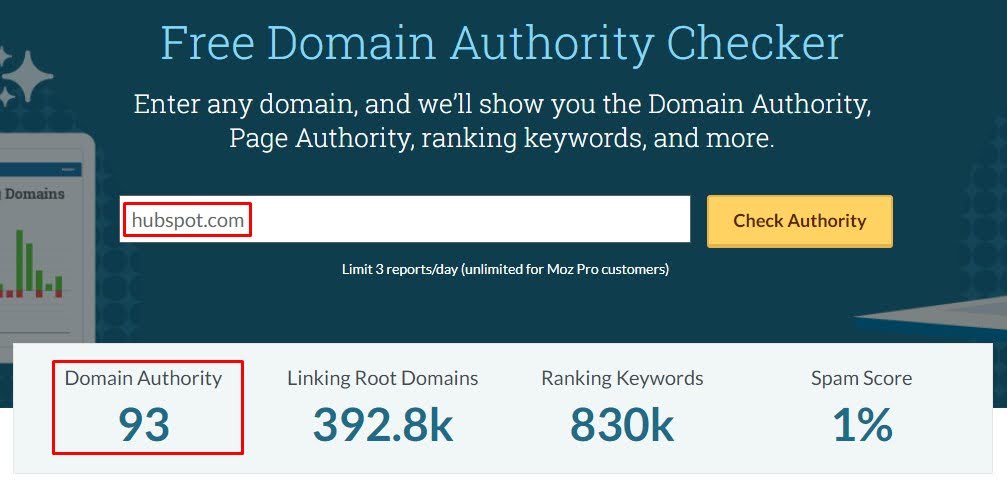
The score is calculated from numerous factors, including linking root domains and the number of total links, aiming to predict how well a website will rank on search engines.
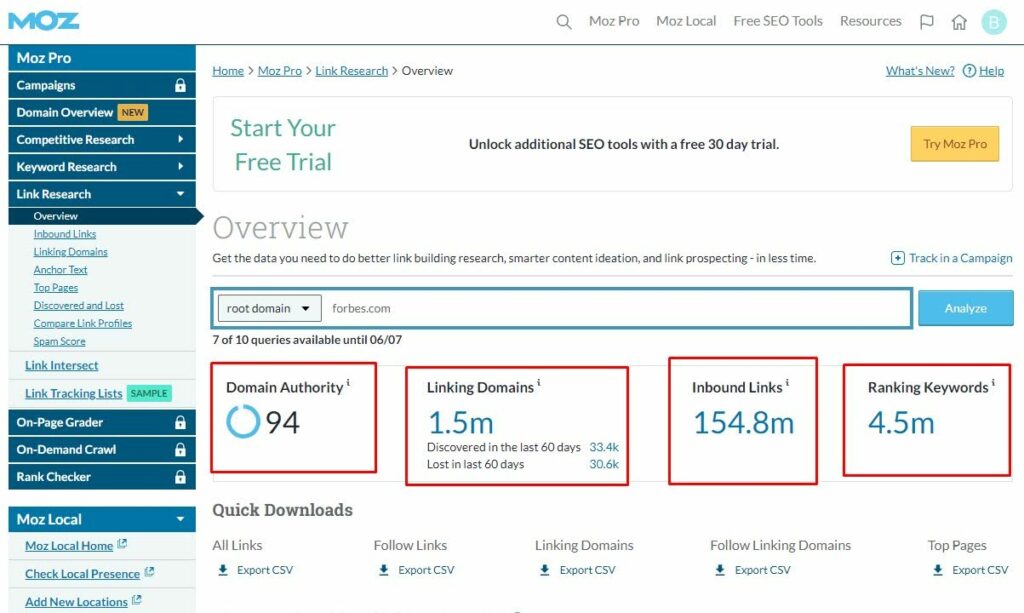
For instance, a website like Forbes or The New York Times enjoys a high DA due to its extensive inbound links and longstanding credibility.

Conversely, sites like startup.info seem to be fine with a DA score of 54 (due to extensive backlinks) but lack substantial credibility or real-world influence when you notice their disproportionately low traffic figures.
Let’s get to Domain Rating so you can see the whole picture.
Domain rating
Domain Rating (developed by Ahrefs) is a more specific metric that evaluates the strength of a website's backlink profile based on the quality of its backlinks.
Sites with high-quality backlinks from authoritative domains tend to have higher domain ratings, indicating a stronger potential to rank well in search engines.
For example, a university website with numerous high-quality EDU links might exhibit a high DR, while a local small business site with fewer and less authoritative links would have a lower rank.


But let’s get back to startup(.)info.
This online magazine for entrepreneurs might seem good with a Domain Rating of 76. However, neither DA nor DR metrics fully reflect the real quality of this site.

A closer look using Ahrefs reveals it only garners a search traffic score of 233 despite having hundreds of articles.

This low traffic indicates that despite its normal DA and DR scores, the site might not be as influential or valuable as it seems to be. In fact, it’s a link farm selling tons of links, which is not cool at all.
Artcreative(.)me, a web design site with a DR of 69, is another great example of a situation when things are not as they might seem at first glance.

Despite what appears to be a robust rating, its search traffic score stands at a mere 41, revealing a significant disparity between its supposed authority and actual online visibility.

Authority score
Semrush's Authority Score is an AI-driven metric that evaluates a domain's authority using three key factors:
- The strength and number of its backlinks (Link Power);
- The average monthly organic search traffic it receives (Organic Traffic);
- The presence of any indicators that might suggest a spammy or unnatural link profile (Spam Factors).
This comprehensive score helps gauge the overall quality and effectiveness of a website's SEO strategy.

High Authority Scores suggest a domain with a lot of influence and robust SEO practices, typically seen in large, well-established companies like Amazon.
In contrast, let’s take writeupcafe(.)com, which covers topics like blogging and making money online.
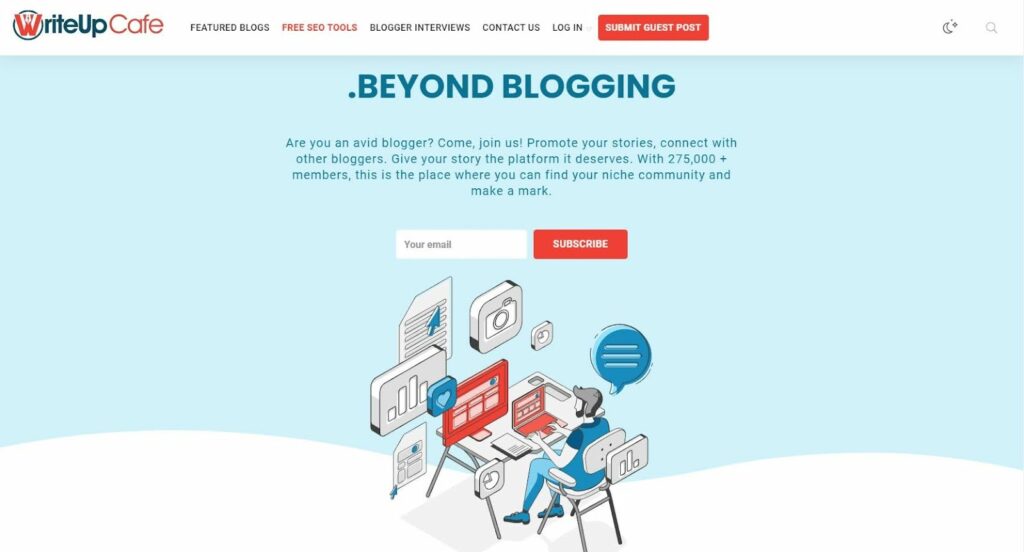
According to Semrush, the site has an Authority Score of 28. However, it also has 1.2K organic search traffic and 36.7K referring domains, which might initially impress.
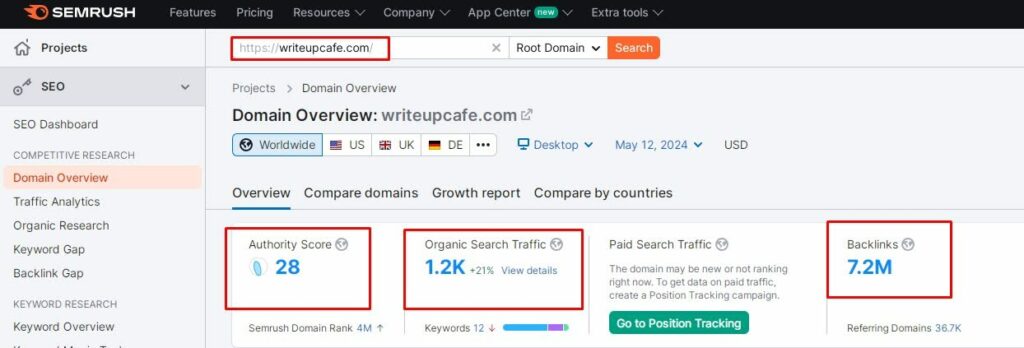
Additionally, according to Ahrefs, the site has a DR of 70. Yet, its search traffic is only 197, which is unexpectedly low for a site covering such popular topics.

Considering such random scores, it’s quite obvious that such a site requires a deeper examination to identify why its substantial backlink profile isn't translating into traffic, and how its content or SEO strategies might be optimized for better performance.
By critically analyzing and cross-referencing various metrics, you can obtain a more accurate assessment of a domain's true strength and potential.
The goal here is not just to target domains with high scores across a few metrics but to ensure that these domains also contribute positively to your site’s SEO performance by driving quality, relevant traffic.
Page Strength
Page strength is crucial for understanding how well an individual page ranks in search engine results.
Let’s take a closer look at the factors that affect it.
What determines page strength?
Page strength is assessed by factors like the quantity and quality of backlinks, the page's relevance, and its overall content quality.
This is where metrics like URL Rating (UR) from Ahrefs

and Page Authority (PA) from Moz are essential.
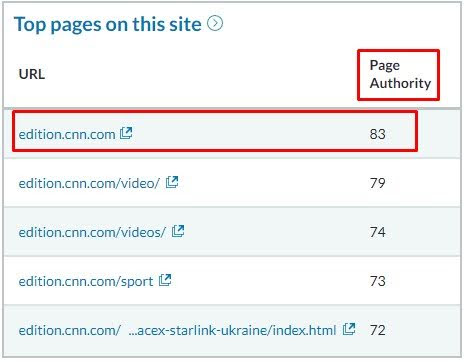
The screenshots above are showing UR and PA results for edition.cnn.com
- UR measures the strength of a page's backlink profile on a scale of 0 to 100, incorporating both internal and external links.
- PA predicts how likely a page is to rank in search results, focusing on link counts and other off-page metrics.
For instance, high-profile pages on sites like Forbes or CNN typically show high UR and PA due to their robust link profiles and content authority.
This can’t be said about the above-mentioned artcreative(.)me, with its UR score:

The situation with the PA score leaves much to be desired, as well:
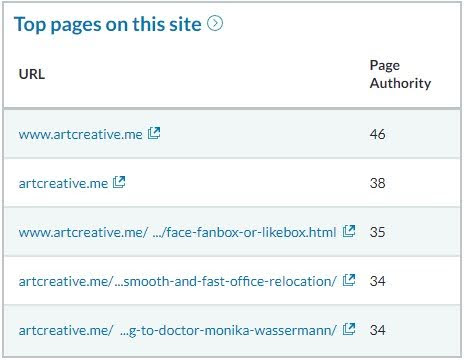
As you can see, a comprehensive approach is crucial. So make sure you check both UR and PA to get a complete picture of a page's potential impact on your SEO performance.
After all, it's about what those numbers signify about the page's real effectiveness in drawing traffic and enhancing your site’s credibility.
Number of Links: Quality Over Quantity
Understanding the number of links pointing to your site is straightforward, but it's the quality that matters.
Let's see why more isn't always better.
Focusing on getting as many backlinks as possible might seem tempting, right? A high number of links might look good at first glance, however, what really boosts your SEO is their quality.
✍️ Related Article: Check out my detailed exploration of this topic in How Many Backlinks Do I Need to Rank?
Want to quickly assess the quality of links?
Here’s a simple trick:
Open Ahrefs and navigate to Referring domains.
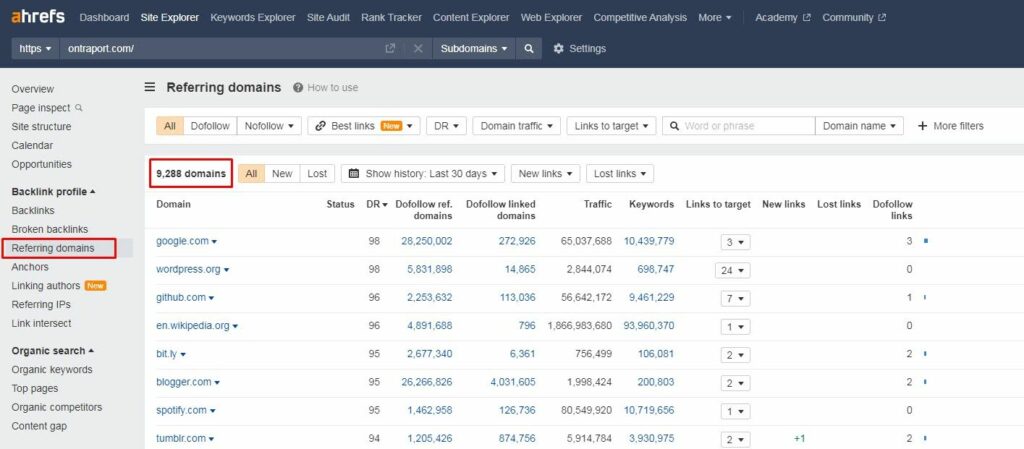
Choose a site from your niche and apply filters for "Domain traffic: From 1K," "DR: From 40," and "Dofollow."
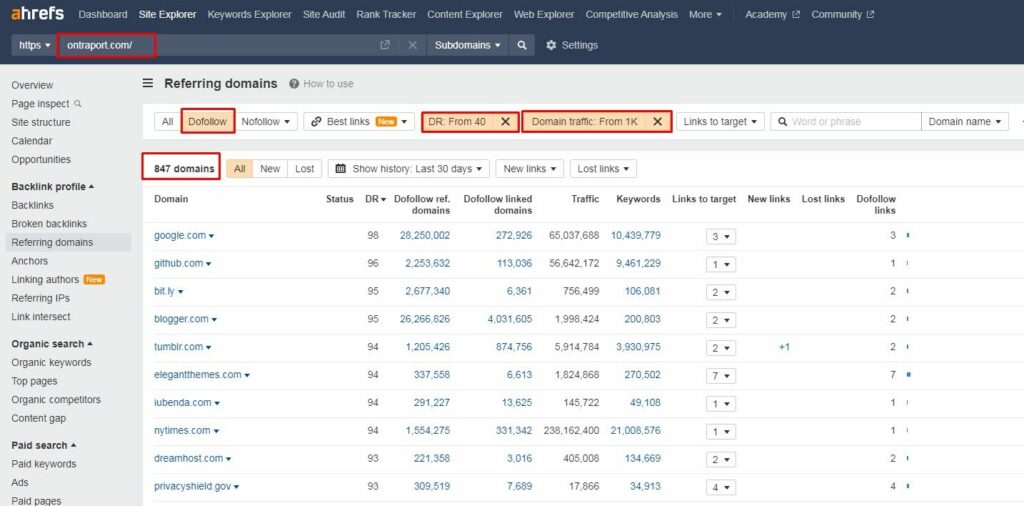
This will show you which links actually carry weight, clearing up the clutter of less impactful ones. As you can see, a site can initially have over 9K ref domains, however, only 847 of them match our parameters.
Why pay attention to link numbers?
Tracking the number of links helps identify if you’re losing valuable ones, which could signal opportunities for re-engagement. Additionally, it lets you compare with competitors, offering insights into the competitive field and helping you track your progress.
In other words, to truly understand the impact of your backlinks, you want to look beyond numbers:
- Domain Strength: Aim for links from domains with a higher DA/DR than yours for better SEO;
- Relevance: Links from related niches are more beneficial as they carry contextual weight;
- Link Saturation: Avoid links from pages crowded with other links. These are less likely to pass significant authority to your site.
Remember, focusing on high-quality backlinks sets your site up not just for more traffic, but for valuable interactions that search engines value and reward.
☝ At Editorial.Link, we understand everything about link metrics and how to balance them effectively. We can help you secure high-quality backlinks from reputable websites, regardless of your site’s DR or DA. Get in touch!
Anchor Text
Though being a small component, anchor text is crucial for your SEO.
Anchor text is the clickable text in a hyperlink that links to a different web page.
Imagine you're reading a blog post and you see a highlighted phrase that you can click on—that's anchor text! It guides users through your site and informs search engines about the relevance of your linked content.
Think of it as a direct pathway that links your content with the broader online community.
Why is anchor text important?
In SEO, anchor text acts as a clear marker for both users and search engines. It signals the content of the linked page, much like a signpost, enhancing both credibility and user experience on your site.
Here's how you can optimize your anchor text effectively:
- Use Descriptive Words: Keep your anchor texts concise, ideally under five words, to maintain clarity;
- Variety is Key: Mix different types of anchor texts—branded, exact match, partial match—to avoid seeming spammy;
- Direct and Informative: Anchor texts should guide users smoothly through your site and offer direct insights about the linked content.
Anchor text provides context to your links, helping search engines understand the relevance of your content, and it structures your site more effectively for user navigation.
Types of anchor text for SEO
You can choose from several types of anchor text:
- Exact Match: Uses the exact keyword;
- Partial Match: Combines the keyword with other words;
- Branded: Incorporates a brand name;
- Naked Links: Just the URL; less effective;
- Generic: Phrases like "click here," which are attention-grabbing but less informative;
- LSI Keywords: Related keywords that predict search intent;
- Images: Clickable images where the alt text is optimized for SEO.
Maximize your SEO impact with these tips:
- Stay Relevant: Make sure your anchor text is closely related to the content it links to;
- Diversify Your Anchor Texts: This helps avoid penalties for spammy practices;
- Keep It Short: Aim for two to five words per anchor text;
- Tools like Ahrefs, Ubersuggest, or Semrush can help you analyze your anchor texts and refine your strategy based on how others link to your site.
By using relevant, varied, and concise anchor texts, you enhance your site's credibility and ease of use.
Checking anchor text with Ahrefs
Want to analyze your anchor text using Ahrefs? Here’s a quick and easy walkthrough to help you get started:
- Step 1: Log In to Ahrefs: First, ensure you have access to Ahrefs. Once you do, log in with your credentials.
- Step 2: Access Site Explorer: Head over to Site Explorer after logging in. This is where you can input the URL of the website you want to check. Just type the URL into the search bar and hit enter.

- Step 3: View the Backlink Profile: Once Site Explorer pulls up your data, click on the "Backlink Profile" section in the sidebar. Select "Backlinks" to see a detailed list of links pointing to your site.
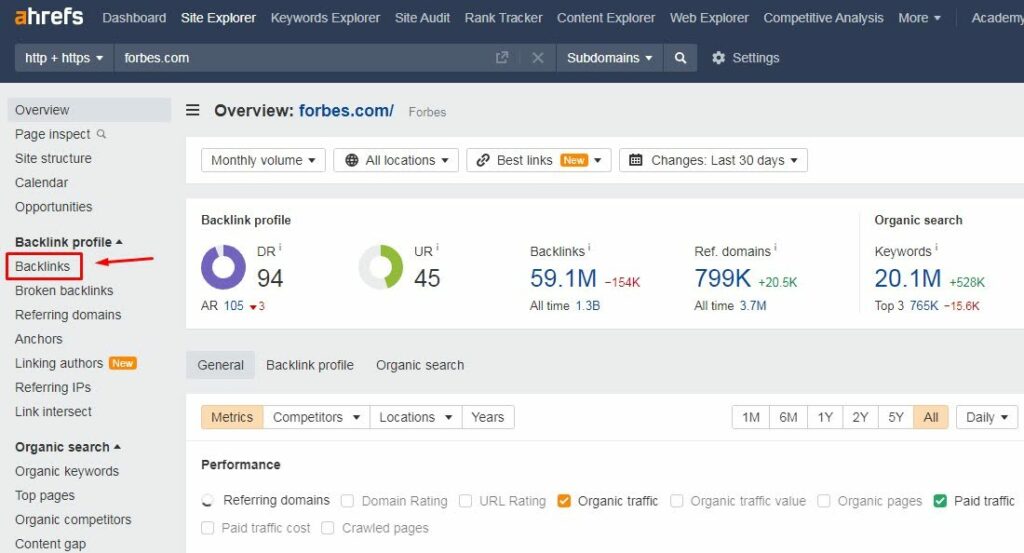
- Step 4: Filter by Anchor Text: In the Backlinks section, you’ll find several filtering options. Click on “+ More filters” and select the “Anchor” filter to specify keywords or phrases.
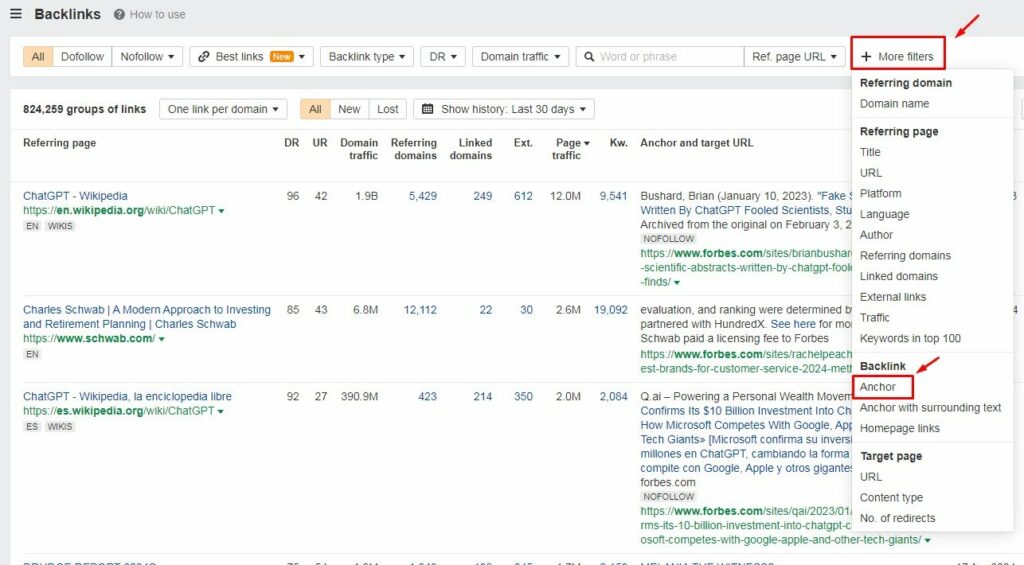
Type in your anchor text. Click “Apply.”

Then click the orange “Show results” button.

Now, you can see all the backlinks using the anchor text, giving you a clear view of how it’s applied across different links.
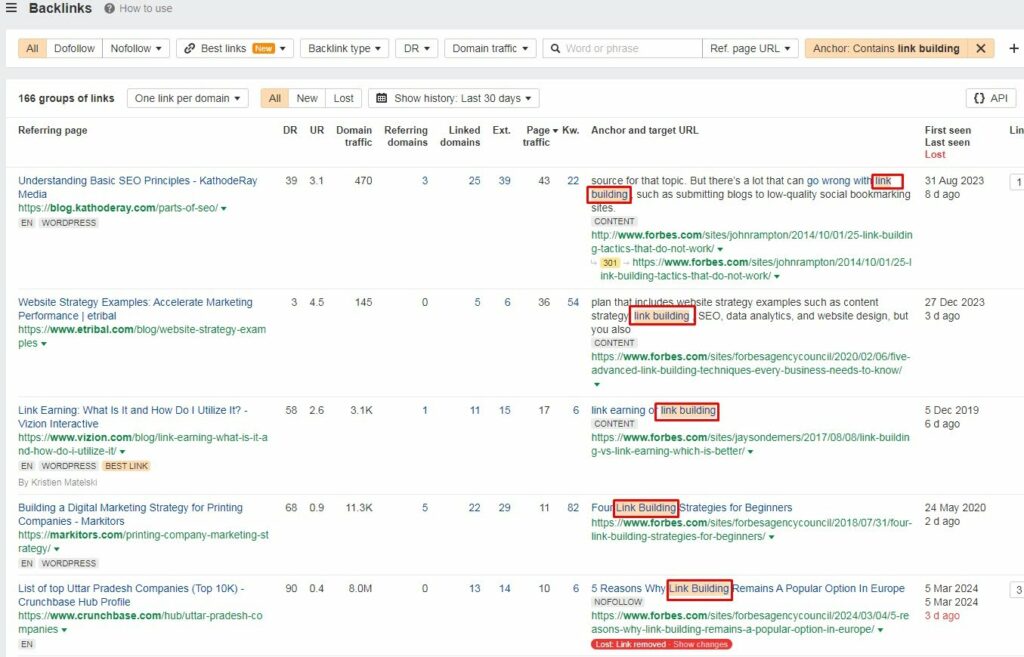
- Step 5: Analyze Your Anchor Text Data: You can now see a list of backlinks with their respective anchor texts. Ahrefs will show you details like the URL, the anchor text used, and the context of each backlink.
You can also check if the link is dofollow by clicking “Dofollow” in the filtering options.
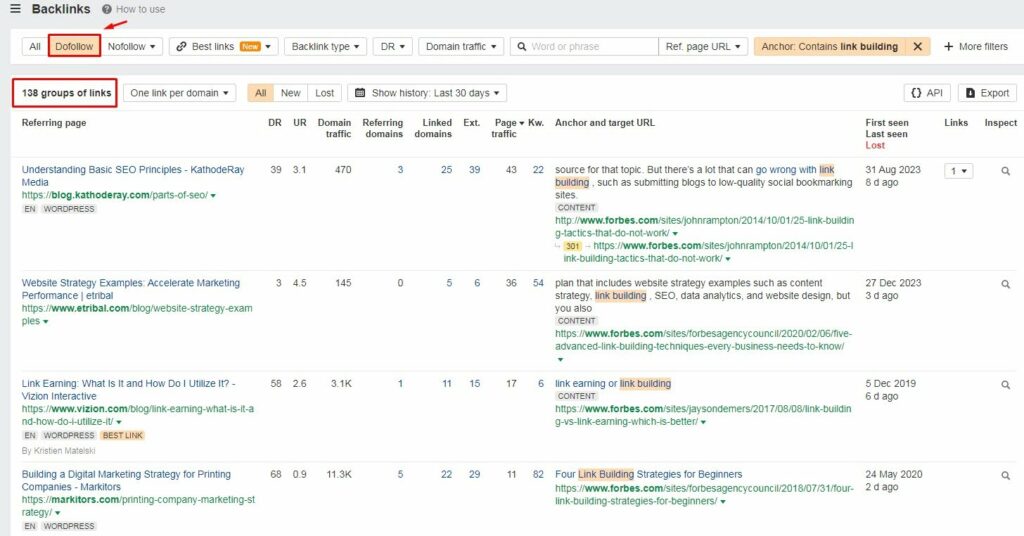
This data is key for evaluating the relevance and quality of your backlinks.
- Step 6: Export Your Data: For deeper analysis or record-keeping, Ahrefs also lets you export this data.
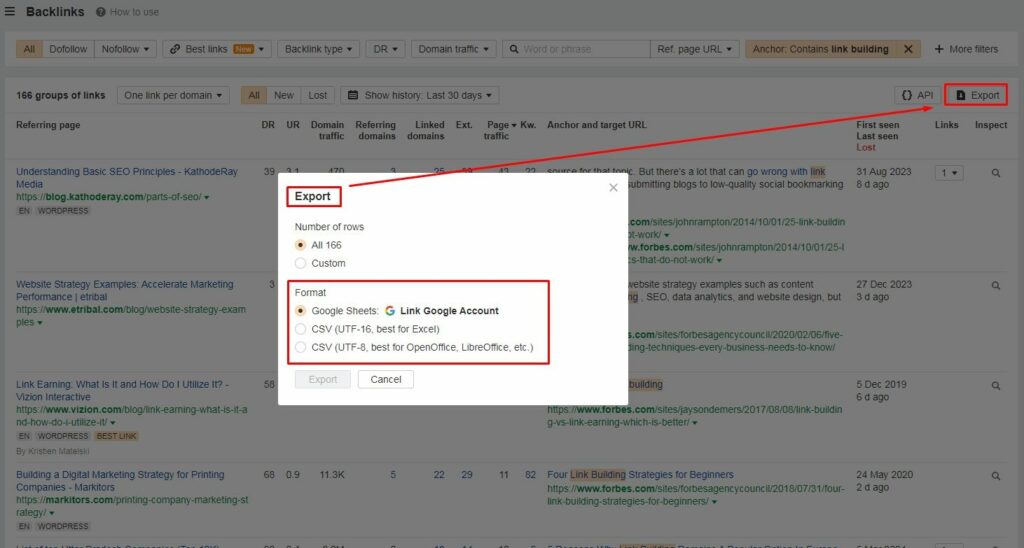
Thus, you can download a list of your backlinks with their anchor texts to an Excel or CSV file by clicking the 'Export' button at the top of the report.

Below you can see what the report looks like after opening it in Google Sheets:

Keep in mind that regular checks on your anchor text through Ahrefs can offer valuable insights into your SEO strategy, revealing how well your site is interconnected across the web. This way you can refine your link-building tactics and boost your rankings in the SERP 😉
Dofollow vs. Nofollow Links
It’s no secret that dofollow and nofollow links play critical and distinct roles in SEO by influencing how search engines interpret the authority and trust of your website:
- Dofollow links contribute directly to your site's search engine rankings by passing on link juice;
- Nofollow links are used primarily for traffic generation without impacting SEO link metrics directly.
✍️ Related Article: Check out my detailed exploration of this topic in Dofollow Backlinks vs Nofollow Backlinks: SEO Benefits
Dofollow links
Dofollow links are essential in SEO as they allow search engines to follow them and pass on what’s known as "link juice" or link equity. This link juice is a ranking power passed from one site to another, helping to improve the recipient site's search engine ranking.
How do you spot a Dofollow link?
Simply locate a random link, right-click on it, and select "Inspect." In the HTML code, if the hyperlink does not include a “rel='nofollow'” tag, it’s considered a Dofollow link.

Nofollow links
Nofollow links include a special “rel='nofollow'” tag in the hyperlink that tells search engines to disregard the link in terms of passing on link equity. While these links don’t contribute to SEO directly, they are crucial for generating user traffic and diversifying your link profile.
How do you identify a Nofollow link?
Check for a Nofollow link by inspecting the page’s HTML source (just like for Dofollow links). A Nofollow link will have a rel attribute such as “rel='nofollow',” “rel='ugc',” or “rel='sponsored'.”
For example, if the Dofollow link in the screenshot above was Nofollow, it would look like this:
<a href="https://ahrefs.com/website-authority-checker/"rel=“nofollow”>Ahrefs' Website Authority Checker</a>.
Why mix dofollow and nofollow?
The answer is simple: balance is key. A balanced mix of Dofollow and Nofollow links ensures a natural and credible backlink profile.
In other words, including both link types signals to search engines that your link acquisition is genuine and not manipulative, which is crucial for maintaining a good ranking.
Here are a few things to remember about dofollow and nofollow links:
- Overusing Dofollow links can seem suspicious to search engines, potentially hurting your rankings. You don’t want that to happen.
- Though Nofollow links don’t improve your SEO directly, they drive referral traffic and enhance visibility. They’re invaluable for spreading the word about your site.
All in all, Dofollow links enhance your site’s authority and improve rankings, while Nofollow links boost referral traffic and support your online presence.
Position of Links on the Page
Where a link sits on a web page significantly impacts its effectiveness for SEO.
But why?
Let's break down why link placement should always matter for your business.
What is link position?
Link position refers to where a link is located on a page—whether it's embedded in the main content, tucked into a sidebar, placed in a footer, or within navigational elements.
Links embedded in the main body of a text and placed higher up on the page tend to engage users more effectively and are prioritized by search engines.
Search engines like Google view the placement of a link as an indicator of its value. A link in the main text is generally seen as more valuable than one in the footer or sidebar because it's likely more relevant to the content and useful to the reader.
Types of links: in-content versus navigation
- In-Content Links: These links are part of the main article or blog post content. They usually support or expand on specific points within the article, adding value and credibility.

For instance, a link from an article about health that directs readers to a trusted medical study reinforces the article's value.
- Navigation Links: Located in site menus, footers, or sidebars, navigation links help users navigate the website but do not significantly enhance SEO directly.

Such links are crucial for user experience and site structure.
Best practices for link placement
- Visibility at the Top: Links placed near the start of your content are more visible to both users and search engines. Such a position can suggest that the link is integral to the primary information shared in the content;
- Context Matters: Ensure that each link relates directly to the text around it. A link that fits seamlessly is more likely to be clicked and valued by search engines;
- Spread Them Out: Avoid cramming links together or hiding them in less accessed page areas like the footer. Such placements can reduce a link's perceived value and might even lead to penalties (if considered spammy by Google).
Remember that effective link placement can improve your SEO by boosting user engagement and telling search engines about the importance and relevance of your content.
Organic Traffic
When scouting for backlink opportunities, keep in mind that organic traffic is an important factor to consider.
Why?
Because it reflects the number of visitors a site attracts through search engines, which is key for determining the value of a potential link.
Here’s what you should know about organic traffic:
- Website Health Indicator: Organic traffic is a strong indicator of a website’s health and its credibility with search engines. A site that draws a lot of organic traffic is likely well-ranked for its key terms, making it a desirable candidate for backlinks;
- Boosts Referral Traffic: Securing a backlink from a website with high organic traffic isn't just good for your SEO—it can also lead to increased referral traffic. A link on a popular site means a higher chance that visitors will click through to your site, offering potential new followers.
Tips on choosing sites for backlinks
- When picking sites for backlinks, their organic traffic levels are crucial. High-traffic sites are often seen as authoritative and trustworthy, which can translate to stronger, more valuable backlinks for your site;
- Balance traffic volume with traffic quality and relevance. This ensures the backlinks you gain are not only powerful in terms of SEO but are also likely to attract genuinely interested visitors to your site;
- Aim to get backlinks from sites that have a robust organic presence in your industry. These sites are beneficial for both their SEO value and their potential to expose your content to a larger, relevant audience;
- Utilize tools that provide detailed insights into organic traffic and other essential metrics like Domain Rating (DR) and Spam Score. You can try Ahrefs’ Website Traffic Checker or Webmaster Tools This helps identify influential and relevant sites for backlinks;
- Monitor the organic traffic trends of your backlink sources. Changes in their traffic could impact your site’s performance, which might require you to adjust your link-building strategies.
Organic traffic is a critical metric for assessing the potential impact of a backlink. It reveals a site’s popularity and search engine standing. Plus, it predicts potential referral benefits that might come from a link.
Relevance of the Linking Page
Understanding the relevance of the linking page means figuring out how closely the content of the page linking to your site relates to your own content. This is a must-do for effective SEO link building.
Why relevance matters?
The relevance of a linking page determines how beneficial the link will be for your site, not just in SEO terms but also in attracting genuine, interested traffic.
For example, if, say, you're promoting an SEO tool in your article, securing a link from a high-traffic, SEO-focused page like HubSpot's article on SEO analysis tools would be incredibly valuable.

This is because the audience is already interested in SEO tools, making them more likely to engage with your product.
And that HubSpot’s page, apart from being relevant, is really good at generating traffic:
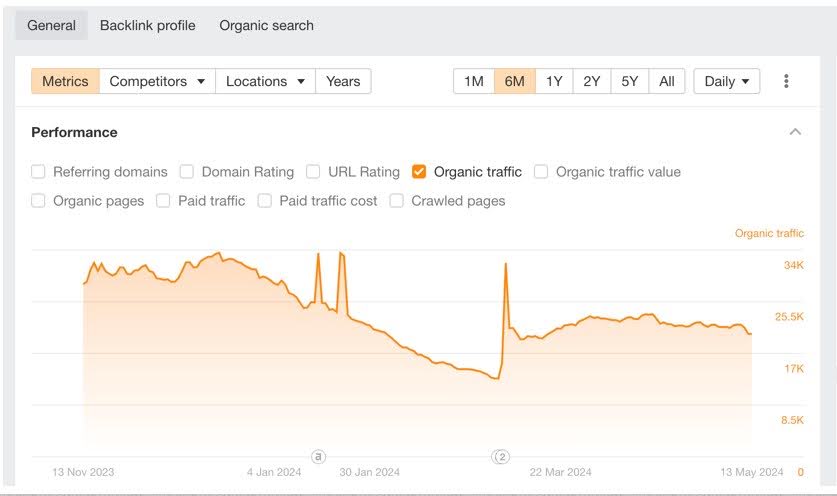
Search engines like Google value relevance because it improves user experience. A link from a closely related page can boost your SEO and attract traffic that’s genuinely interested in your content.
Strategic link placement example
Here’s another example of strategic link placement:
Linking to my guide on the best link-building tools from HubSpot’s page about the best internal linking tools makes total sense. After all, it matches the context and enriches the reader's experience by providing related, useful content.
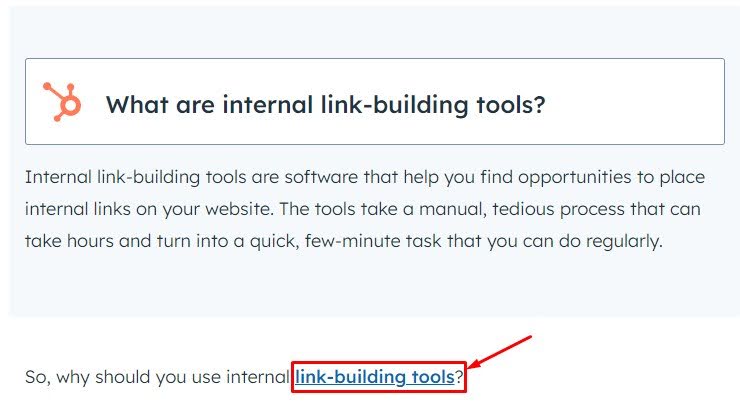
That said, check out the following dual benefits of relevant links:
- Attracting Potential Customers: Links from pages relevant to your business draw in an audience that’s already interested in your niche. For example, a landscaping business will benefit more from a link on a gardening site than one on a gaming blog.
- Enhanced SEO Value: Relevance is increasingly critical in SEO. Search engines are shifting focus from mere keywords to the broader context of linked content, assessing how well the link fits within the thematic content of the page.
🎯 Tip: When setting up your link-building efforts, always aim for connections that resonate with your content and business objectives, maximizing the effectiveness of each link.
Final Thoughts
As you can see, mastering backlink metrics is essential for optimizing your SEO strategy and enhancing your site's visibility.
These metrics guide your link-building campaigns, helping you target your efforts effectively and measure success through increased link counts, improved domain and page strength, and ultimately, higher organic traffic.
Ready to enhance your website's backlink profile with precision?
🚀 Editorial.Link partners with top-tier companies to provide you with high-authority, contextually relevant links that boost your SEO. Regardless of your site’s current DR or AS, we ensure that every backlink adds real value, enhancing your site's credibility and search ranking.

